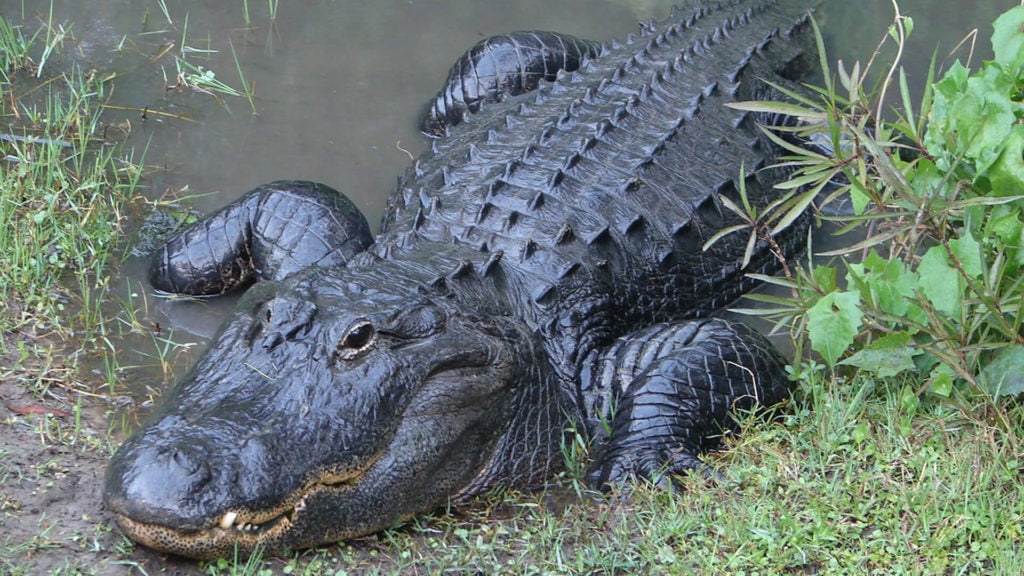I’m Cold Blooded, Check It and See! The American Alligator

Most of us probably know that American alligators are ectothermic, or cold-blooded, but read on for other facts about gators you may not know!
We may think that gators reside primarily in Florida (think the University of Florida Gators), but even though they are found in all of the state’s 67 counties, they can also be found as far west as southeast Oklahoma and east Texas and as far northeast as North Carolina.
This species looks like a dinosaur because it is a dinosaur. Alligators, a species that is more than 150 million years old, are the last of the living reptiles that were closely related to dinosaurs. Today, their closest modern kin are birds.
There is only one other alligator species, the Chinese alligator.
Because alligators are ectotherms, they do not eat much; a 100-pound dog will eat more in a year than an 800-pound alligator.
Alligators “pant” to cool themselves off. Okay, not quite, but on hot summer days you may see them basking in the sun with their mouths open, which is a cooling mechanism similar to a dog’s panting.
Alligators and crocodiles, while related, are different! Alligators have a broad, rounded snout with no teeth visible while their jaw is closed. The American crocodile, on the other hand, has a narrow snout with the fourth tooth of the lower jaw protruding when closed. They are found in south Florida but primarily in southern Mexico, Central America, the Caribbean, and northern South America.
Male alligators can grow to be as much as 15 feet long! They can be as small as 10 feet in length, but females rarely exceed 10 feet.
We usually think of gators as green, but this is not accurate. They are actually brownish-gray, but the green algae and floating vegetation that frequently sticks to their backs contributes to this misconception.
Alligators have fairly poor eyesight because they have a “nictitating membrane” which protects their eyes so they can see underwater, while their ears, located behind their eyes, are very sensitive to vibrations in the water.
Do you think a male’s bellowing could be attractive? Female alligators do! That is how the males attract the opposite sex during their breeding season beginning in May. Alligator courtship also involves a variety of vocalizations, head-slapping on the water’s surface, body posturing, snout and back rubbing, bubble blowing, and pheromone or scent signals. By June these tactics have worked, as pairs have mated and females begin building mound nests out of marsh reeds or other vegetation for between 20 and 60 eggs.
Alligators are cannibals! There is about a 1 in 16 chance that mature gators will eat babies. This allows them to conserve food resources and keep their population stable. In spite of this, an alligator’s life span in the wild can reach 35 to 50 or even 60 years and beyond.
Mother alligators do their best to prevent this cannibalism and other predators’ attacks, as they aggressively defend their young for more than a year after they have hatched.
And yes, alligators can eat humans. They are opportunists, which means when they are hungry they will eat just about anything, including carrion, pets, and us, in rare instances. However, they feed mainly on fish, turtles, snakes, and small mammals.
If you and your local conservation agency deem a gator a “nuisance,” it can be removed, but possibly not for long! Because alligators have a strong homing instinct, relocated individual alligators can return home even after they have been moved over 100 miles!
Even though we are afraid of them, gators really should be afraid of us. The main threat to the American alligator is the destruction and degradation of its wetland habitat, primarily through human development. But we’re not the only ones to blame, as alligator nests may be preyed on by raccoons and bears and juvenile gators by wading birds, otters, and larger alligators.
The American alligator is protected under the Endangered Species Act as a Threatened species, but for an unexpected reason. While it was previously on the endangered list, its population has recently surged to more than one million due to state and federal protections, habitat preservation efforts, and reduced demand for alligators products. It is still federally listed as threatened because its look-alike, the American crocodile, is endangered.
But this doesn’t mean that we no longer need to focus on the conservation of the alligator. Remember that they do not want to hurt you, and although they may love for you to feed them, it is unhealthy and dangerous to do so because they could get accustomed to handouts and human presence. They have survived 150 million years; let’s help them survive at least 150 million more!
Come see a “congregation” of gators for yourself in their natural wetland habitats with us on a Cumberland Island Walking Tour!


